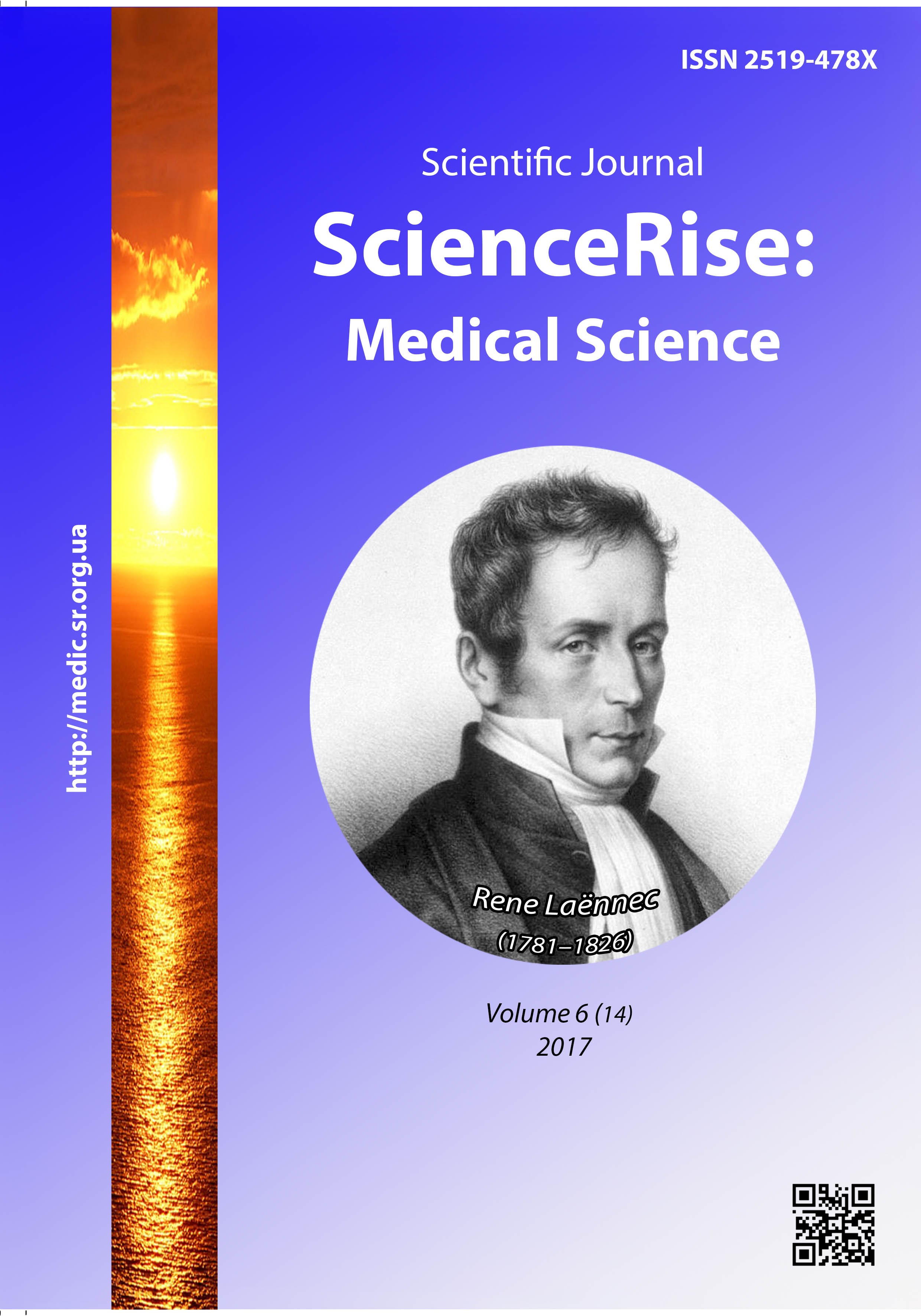Endometrial pathology and reproductive profile of women in late reproductive and premenopausal age
DOI:
https://doi.org/10.15587/2519-4798.2017.105648Keywords:
pathology of endometrium, reproductive profile, premenopausal, late reproductive age, integral diagnostic systemAbstract
The aim of the study was to determine the features of the structure of intrauterine pathology and obstetric and gynecological history of women in the late reproductive and premenopausal period.
Materials and methods. In the observational cross-sectional retrospective study by the continuous sampling method, 849 histories of the disease of women of all age groups with pathology of endometrium were selected. Inclusion criteria: presence of one or more endometrium pathologies - endometrial polyp, endometrial hyperplasia, chronic endometritis, intrauterine sinechia.
Results and conclusions. More than a third of patients (37.3%) with pathology of endometrium are women of late reproductive and premenopausal age. Women of late reproductive and premenopausal age are a group of high-risk endometrium pathology, whose structure is dominated by endometrial polyps and endometrial hyperplasia, in combination with endocrine-related pathology. Current is the development of a comprehensive system of diagnosis, prevention and treatment of endometrial pathology in women of late reproductive and premenopausal age on the basis of the etiopathogenetic personified approach.
References
- Zaporozhan, V. N., Tatarchuk, T. F., Dubinina, V. G., Kosei, N. V. (2012). Modern diagnostics and treatment of endometrial hyperplastic processes. Reproductive endocrinology, 1 (3), 5–12.
- Sidorova, I. S., Sheshukova, N. A., Fedotova, A. S.(2008). Modern view on the problem of hyperplastic processes in the endometrium. Russian bulletin of obstetrician-gynecologist, 8 (5), 19–22.
- Lacey, J. V., Chia, V. M. (2009). Endometrial hyperplasia and the risk of progression to carcinoma. Maturitas, 63 (1), 39–44. doi: 10.1016/j.maturitas.2009.02.005
- Lacey, J. V., Sherman, M. E., Rush, B. B., Ronnett, B. M., Ioffe, O. B., Duggan, M. A. et. al. (2010). Absolute Risk of Endometrial Carcinoma During 20-Year Follow-Up Among Women With Endometrial Hyperplasia. Journal of Clinical Oncology, 28 (5), 788–792. doi: 10.1200/jco.2009.24.1315
- Smetnik, V. P., Tumilovich, L. G. (2006). Non-operative Gynecology. Moscow: MIA, 632.
- McGurgan, P., Taylor, L. J., Duffy, S. R., O’Donovan, P. J. (2006). Are endometrial polyps from pre-menopausal women similar to post-menopausal women? An immunohistochemical comparison of endometrial polyps from pre- and post-menopausal women. Maturitas, 54 (3), 277–284. doi: 10.1016/j.maturitas.2005.12.003
- Martirosyan, K. A., Karachencova, I. V., Politova, A. P. et. al. (2011). Complex treatment hiperplastic endometrium processes of the patients during pre- and postmenopause periods. Bulletin of the Russian State Medical University, 2, 106–109.
- Lacey, J. V., Chia, V. M., Rush, B. B., Carreon, D. J., Richesson, D. A., Ioffe, O. B. et. al. (2012). Incidence rates of endometrial hyperplasia, endometrial cancer and hysterectomy from 1980 to 2003 within a large prepaid health plan. International Journal of Cancer, 131 (8), 1921–1929. doi: 10.1002/ijc.27457
- Dubossarskaya, Z. M., Dubossarskaya, Yu. A. (2009). Hyperplasia of endemembria (clinical lecture). Female doctor, 5, 22–27.
- Sukhikh, G. T., Nazarenko, T. A. (Eds.) (2010). Infertile marriage. Modern approaches to diagnosis and treatment: a guide. Moscow: GEO-TAR_Media, 784.
- Sanders, B. (2006). Uterine factors and infertility. J. Reprod. Med., 51 (3), 169–176.
- Oliveira, F. G., Abdelmassih, V. G., Diamond, M. P., Dozortsev, D., Nagy, Z. P., Abdelmassih, R. (2003). Uterine cavity findings and hysteroscopic interventions in patients undergoing in vitro fertilization–embryo transfer who repeatedly cannot conceive. Fertility and Sterility, 80 (6), 1371–1375. doi: 10.1016/j.fertnstert.2003.05.003
- Feoktistov, A. A., Ovsyannikova, T. V., Kamilova, D. P. (2009). Estimation of frequency, morphological and microbiological structure of chronic endometritis in patients with tubal peritoneal form of infertility and unsuccessful attempts of in vitro fertilization. Gynecology, 11 (3), 31–34.
- Korniyenko, S. M. (2017). Optimization of the treatment of endometrial hyperplastic processes in the late reproductive period using hysteroscopic technique of "cold loop". Reproductive endocrinology, 3 (35), 44–49.
- Van den Bosch, T., Ameye, L., Van Schoubroeck, D., Bourne, T., Timmerman, D. (2015). Intra-cavitary uterine pathology in women with abnormal uterine bleeding: a prospective study of 1220 women. Timmerman Facts Views Vis Obgyn, 7 (1), 17–24.
- Tatarchuk, T. F., Kalugina, L. V., Tutchenko, T. N. (2015). Hyperplastic processes of endometrium: what's new? Reproductive Endocrinology, 5 (25), 7–13. doi: 10.18370/2309-4117.2015.25.7-13
- Cho, H. J., Lee, E. S., Lee, J. Y. et. al. (2013). Investigations for postmenopausal uterine bleeding: special considerations for endometrial volume. Arch Iran Med., 16 (11), 665–670.
- Zaidieva, Ya. Z. (2008). The risk of hyperplastic endometrial processes in menopause (review of the literature). Pharmateka, 1, 9–14.
- Tatarchuk, T. F., Kosey, N. V., Tutchenko, T. N., Juping, V. A. (2014). A new era in the treatment of uterine fibroids in women of different age groups. Reproductive endocrinology, 6 (20), 9–20.
- Stewart, E., Cookson, C., Gandolfo, R., Schulze-Rath, R. (2017). Epidemiology of uterine fibroids: a systematic review. BJOG: An International Journal of Obstetrics & Gynaecology. doi: 10.1111/1471-0528.14640
Downloads
Published
How to Cite
Issue
Section
License
Copyright (c) 2017 Svetlana Korniyenko

This work is licensed under a Creative Commons Attribution 4.0 International License.
Our journal abides by the Creative Commons CC BY copyright rights and permissions for open access journals.
Authors, who are published in this journal, agree to the following conditions:
1. The authors reserve the right to authorship of the work and pass the first publication right of this work to the journal under the terms of a Creative Commons CC BY, which allows others to freely distribute the published research with the obligatory reference to the authors of the original work and the first publication of the work in this journal.
2. The authors have the right to conclude separate supplement agreements that relate to non-exclusive work distribution in the form in which it has been published by the journal (for example, to upload the work to the online storage of the journal or publish it as part of a monograph), provided that the reference to the first publication of the work in this journal is included.









